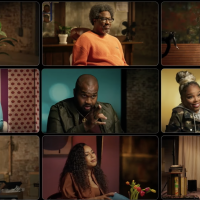It doesn’t feel like an exaggeration to say that Mira Jacob’s latest book Good Talk is a blueprint for a kinder world. In this graphic memoir, Jacob details a lifetime of difficult conversations—about politics, about race, about love and relationships. Seeing her handle these tricky talks, sometimes awkwardly and imperfectly, is like a survey course in how we disagree—and how we learn to live together anyway.
Jacob narrowed down her picks for our Read More Women series by choosing, she said, books that gave her the permission that the world doesn’t always give—books “that kept me going with their inventiveness, their ability to march outside borders.”
Read More Women is Electric Literature’s series, presented in collaboration with MCD Books, in which we feature prominent authors, of any gender, recommending their favorite books by women and non-binary writers. Twice a month, you’ll hear about the five non-male authors who most delight, inspire, and influence your favorite writers.
A few years ago, I sat down to draw a book about America. I had never drawn a book before. I had never even said out loud, “I’m going to draw a book.” To complicate things, as a brown kid of immigrants, I’ve always felt a little behind on everything—less entitled to takes huge risks or even small steps into uncharted territory. Wasn’t I lucky just to be in the novelist room at all? Shouldn’t I stay there?
But as things started getting worse in the country, as friends started showing up at my house scared and sickened, and my family splintered along race lines, something in me cracked open and no amount of well-wrought sentences could seal it back up. Drawing, though, helped. Drawing people especially—the ones I was worried for, the ones I was worried about. Some of these books I listened as I drew, some I reached for on nights when I could not sleep, some I remembered and re-read because I found them brave and wild and inventive in ways that made me feel like many things were possible.
What It Is by Lynda Barry
A longtime fan of Barry (and Marlys, the deeply awkward heroine of her ’90s comic strip, Ernie Pook’s Comeek), I stumbled into What It Is when I was trying to scare myself away from graphic work. It’s easy enough to do when you imagine entering a field of white dudes who basically have charcoal pencils for fingers, but decidedly less so when you crack open this brilliant tome that takes on the central question of what drives us to draw stories. Part memoir, part instructional manual, this combination of collages, essays and assignments breaks down all the moving parts of being an artist and allows you to hold each one, to imagine how it might live in you.

Bright Lines by Tanwi Nandini Islam
Tanwi Nandini Islam (a.k.a Tanaïs) is perpetually ahead of their time in vision and scope, as is evident in this lush, electric novel, which centers around three Bangladeshi Americans navigating inherited trauma while living outside of racial, religious, and gender norms. If that sounds like a lot, it’s because it is, but that precisely the joy of their work—the way it does not give up a single facet of its complication, the way it imagines itself so fully and gloriously that we are forced to do the same.

Citizen by Claudia Rankine
Yes, it was a National Book Award finalist, one that deftly connected the dots between the kinds of actions that whiteness will not identify as racism and the toll that action takes on blacks and brown bodies. But what I love most about this book is its form—the way Rankine soars from poem to criticism to prose to cultural commentary, the way turning each page becomes a surprise because we cannot predict where she will go next. The willingness to bend her words toward any form her subject demands makes this book an acrobatic and breathless read.

A Visit from the Goon Squad by Jennifer Egan
Listen, I have no idea if this book was fun to write but can I just say, it really, really seems like it was? Each of these stories is astonishing in its own right, but all together, it’s a stunner of a collection. I don’t know if Egan herself would love being called playful, especially when her sentences are cut with a jeweler’s precision, but the way she flips perspective and place and voice and time in these interlinked stories, the way she trusts her readers to stay for the minutes and decades? Yes, please.

The God of Small Things by Arundhati Roy
“But why did she have to write such terrible things about our community? Now the whole world will look at us and see this filth!” one of my Syrian Christian aunts lamented when this book published in 1997. Roy’s book, the story of fraternal twins whose lives are destroyed by a series of terrible secrets, went on to win the Booker Prize, and has taken up permanent residence in my mind as a book as sentence-by-sentence beautiful as it is instructive. For years I had been unwilling to discuss the worst parts of my community, knowing that it would only bring negative attention from eyes already prone to dismissing or belittling us. That changed after reading this book, after seeing parts of my own cultural experience fictionalized in a way that allowed me to reckon with them. To know myself. I always come back to this when I get scared: what it means to write the truth, and who you write it for.
The post Mira Jacob Recommends 5 Inspiring Books That Aren’t By Men appeared first on Electric Literature.
Source : Mira Jacob Recommends 5 Inspiring Books That Aren’t By Men













